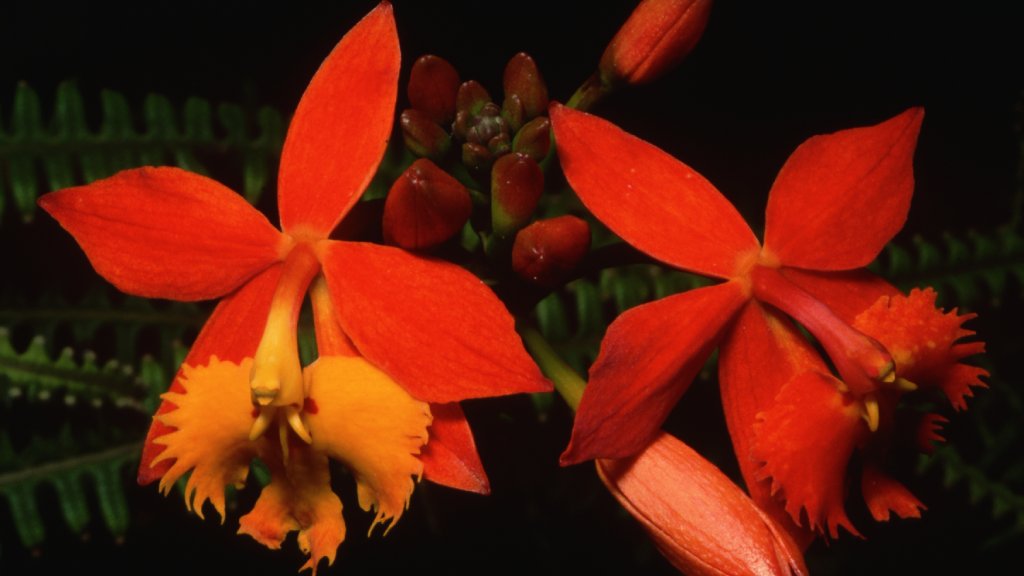Epidendrum Radicans Or Reed Orchid Care & Characteristics
Epidendum radicans or “reed orchids” can be garden-grown in warmer regions, and are easy to grow indoors or out.


Quick Reed OrchidFacts:
- Botanical name - Epidendrum ibaguense, Epidendrum radicans
- Height - 3 ft. (1 m.)
- Spread - 18 in. (45 cm.)
- Sun exposure - Bright, Indirect Light; Part Sun
- Soil requirements - Orchid Mix, Well-Drained Acidic Soil
- Hardiness zones - USDA Zones 8-11
- When to plant - Spring
Reed Orchid Uses
Also known as crucifix orchids, reed stem orchids are among the easiest orchids to grow. Though several species are commonly referred to as “reed orchids,” most have very similar growth habits and needs.
While gardeners successfully grow these tender plants indoors, those living in frost-free garden zones may even be able to grow the species outside, in containers or flower beds. When in bloom, reed orchids produce a profusion of vibrant red-orange flowers atop tall stems. Because the plants flower quite readily, they’re a good choice for novice orchid enthusiasts, as well as anyone hoping to add a bright burst of color to the home landscape. Learn more here about the specific needs of reed orchids.
Reed Orchid Care
Many orchids need special containers, but terrestrial reed orchids can be grown directly in the garden in their hardiness regions. In the garden, these plants require beds rich in nutrients and soil that drains well. Reed orchids appreciate warm, humid climates. Container grown orchids do best in a potting mix specifically formulated for their growth, usually consisting of bark and perlite.
Light is also important to promote blooms. Orchids should receive bright, indirect light. Those grown outdoors will benefit most from early morning sun, or extended periods of dappled light throughout the day. While too much sun may cause the plants’ leaves to yellow or become sunscorched, inadequate light can prevent flower buds from initiating. Reed orchids also benefit from routine applications of a well-balanced, slow-release fertilizer throughout the growing season.
Water Needs
During active periods of growth, consistent soil moisture provides the plant with ideal conditions needed for the production of flowers. In areas where there are prolonged periods of drought, supplemental watering becomes necessary. But, be careful not to allow the soil to dry completely and, just as importantly, take care not to overwater the plants. Becoming waterlogged can be detrimental to the overall health of the plants. As the weather begins to change in autumn, it’s best to reduce the frequency of watering in preparation for the cooler months.
Problems, Pests, & Diseases
Root rot, as the direct result of overwatering, is often a concern when growing reed orchids. Most instances of rot can be avoided by paying special attention to soil moisture levels. Small insects, like aphids, may also become problematic. Stay vigilant throughout the growing season, taking careful note of early signs of infestation. In most instances, orchid pests and disease do not pose a serious threat to reed orchid plants.
Propagation
Propagation of reed orchids is relatively simple. New plants can be created by rooting stem cuttings and through division. To propagate new cuttings, each one should be placed into a moist potting medium. Throughout the rooting process, be sure to maintain adequate levels of light and humidity.
Gardening tips, videos, info and more delivered right to your inbox!
Sign up for the Gardening Know How newsletter today and receive a free copy of our e-book "How to Grow Delicious Tomatoes".
Reed orchids spread quickly through underground rhizomes. Each plant can be easily cut apart and potted into its own container. Pups produced on stems can also be rooted and placed into containers in this manner.

Tonya Barnett has been gardening for 13 years. Flowers are her passion. She has transformed her backyard into a cut flower garden, which she regularly chronicles on her YouTube channel http://www.youtube.com/@tonyawiththeflowers.
-
 10 Common Composting Problems That Can Spoil Your Garden Gold – Plus Easy Fixes
10 Common Composting Problems That Can Spoil Your Garden Gold – Plus Easy FixesLearn how to troubleshoot common composting issues before they ruin your stash – from bad smells and bugs to materials not breaking down as they should.
By Susan Albert
-
 Terrifically Tubular Flowers For Hummingbirds: 9 Tube-Flowered Plants To Attract Hummers
Terrifically Tubular Flowers For Hummingbirds: 9 Tube-Flowered Plants To Attract HummersGrowing tubular flowers for hummingbirds helps you create the optimum feeding conditions for your winged friends. Here are nine tubed delights for hummers
By Tonya Barnett